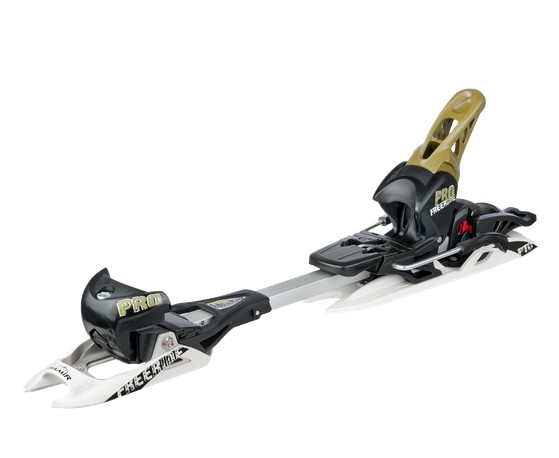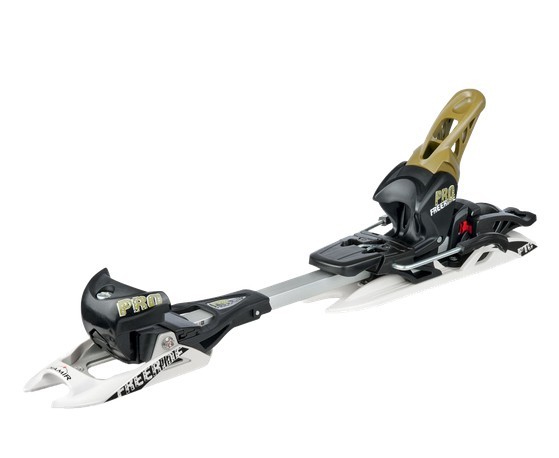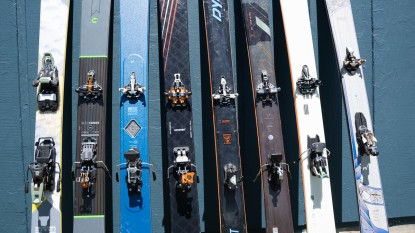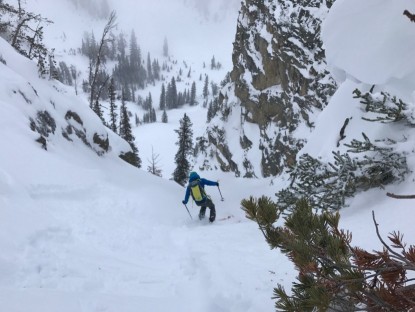Fritschi Freeride Pro Review
Our Verdict
Our Analysis and Test Results
Ease of Use
This model is one of the easiest to use bindings in our review. To step into it is just like stepping into a traditional alpine binding; undoubtedly, this action is easier and takes less overall body coordination to get into than any tech style binding. For lighter users (sub 135 lbs), this model is noticeably easier to step into than the Marker Duke or Marker Baron 13 EPF, where our lighter testers often struggled to generate enough force to get the heel piece to flip over and clamp down.
While touring on this model, it does commonly get icing near the heel of the binding, which can prevent the user from transitioning from a free heel to a locked heel. While the icing itself is somewhat of a common occurrence, our testers agreed that it's very easy to clear out, often just knocking the ice free using a ski pole.
Touring Performance
This competitor features the best touring performance of any frame style binding in our review and the heel risers are much easier to engage than either of the Marker's frame style bindings. It utilizes a more optimal pivot point than the Marker Duke or Salomon Guardian MNC 16; this is because it's over a pound and a half lighter. While this model is an excellent touring option, especially when compared to other frame style bindings, we still prefer any tech style binding (except the Dynafit Beast 16) for an exclusively or mostly touring option, as they are 1.5-2 lbs lighter weight.
Transitions
This contender likely the easiest overall transitioning binding in our review, even easier than any tech style binding we tested. To transition this model, just flip the heel piece up or down to switch between downhill and uphill mode. Transitioning is typically the most hassle-free experience of any touring binding we tested.
Downhill Performance
Overall, this binding has very good downhill performance, though but it isn't quite as good as the Marker Duke or Marker Baron 13 EPF. Both of the Marker bindings offer more surface area within the binding that creates a more positive connection. While hardly a horrible amount, this model does have marginally more play in the binding from the mechanism used to lock down the heel, resulting in less efficient boot to binding, and binding to ski connection.
The difference in stack height (which is the height of the boot above the ski) is marginally higher on this contender (39 mm) than that of the Marker Duke or Marker Baron (which are 36 mm). That said, this difference was pretty negligible, and the additional 3 mm in height shouldn't play a huge factor in your buying decisions.
Durability
While this model is pretty darn durable, it's not quite as tough as the Marker Baron or Duke, though we still know plenty of folks who rip on these bindings in the resorts. Most folks would be fine using them as a day-in day-out primarily in-bounds binding, but they just aren't as burly as Duke's or Baron's.
Weight
At 4 lbs 8 oz, this model is still heavier than all of the tech bindings in our review; this competitor is still over a pound and a half lighter than the 6 lbs 2 oz Duke, or the even heftier 6 lbs 8 oz Saloman Guardian.
Best Applications
This model is best for skiers who own one set up and want to do resort ski and tour close to a 50-50 split, or want to tour more than 50% of the time, but don't own a boot with tech inserts.
Value and the Bottom Line
At $530, this competitor is $80 more than the Maker Duke EPF ($450) and $150 more than the Marker Baron EPF. For the extra money, you do get a binding that's much easier to use and offers superior touring performance than either of the aforementioned bindings; however, it doesn't perform on the down quite as well, nor is it quite as durable.
Conclusion
This model sits a bit in the middle as far as touring bindings go. It tours far better than any of the other frame style bindings in our review, but doesn't perform quite as well on the down; it doesn't tour as well as any of the tech style bindings. For certain people it can be a great binding, but for mostly in-bounds use, we recommend a Marker Baron 13 EPF or Duke; for primarily touring applications, we'd recommend a tech binding. For someone who is truly in between, this model could be the perfect fit.





